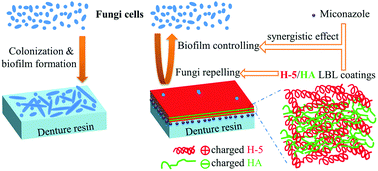当前位置:
X-MOL 学术
›
J. Mater. Chem. B
›
论文详情
Our official English website, www.x-mol.net, welcomes your
feedback! (Note: you will need to create a separate account there.)
Salivary polypeptide/hyaluronic acid multilayer coatings act as “fungal repellents” and prevent biofilm formation on biomaterials†
Journal of Materials Chemistry B ( IF 6.1 ) Pub Date : 2018-02-08 00:00:00 , DOI: 10.1039/c7tb02592k Jianchuan Wen 1 , Chih-Ko Yeh , Yuyu Sun
Journal of Materials Chemistry B ( IF 6.1 ) Pub Date : 2018-02-08 00:00:00 , DOI: 10.1039/c7tb02592k Jianchuan Wen 1 , Chih-Ko Yeh , Yuyu Sun
Affiliation

|
Candida-associated denture stomatitis (CADS) is a common, recurring clinical complication in denture wearers that can lead to serious oral and systemic health problems. Current management strategies are not satisfactory due to their short-acting and ineffective therapeutic effects. Here, we describe a new fungal biofilm controlling strategy using the polyelectrolyte layer-by-layer (LBL) self-assembly technology on denture materials. Conventional poly(methyl methacrylate) (PMMA) denture material discs were functionalized with negatively charged poly(methacrylic acid) (PMAA) via plasma-initiated surface grafting, followed by repetitive alternating coating with the salivary antimicrobial polypeptide histatin 5 (H-5; cationic polymer) and hyaluronic acid (HA; anionic polymer). On the other hand, the H-5/HA LBL coatings (i.e., the outermost layer was H-5) inhibited fungal attachment/adhesion, significantly reduced fungal biofilm formation, and showed synergistic effects with the antifungal drug miconazole. LBL surface hydrophilicity was not the key mechanism in controlling Candida biofilm formation. The current approach demonstrates the utility of a new design principle for fabricating anticandidal denture materials, as well as potentially other related medical devices, for controlling fungal biofilm formation and combating insidious infections.
中文翻译:

唾液多肽/透明质酸多层涂层充当“真菌驱避剂”并防止生物材料上的生物膜形成†
念珠菌相关假牙口炎 (CADS) 是假牙佩戴者常见的、反复出现的临床并发症,可导致严重的口腔和全身健康问题。当前的管理策略由于其短效和无效的治疗效果而不能令人满意。在这里,我们描述了一种在义齿材料上使用聚电解质逐层 (LBL) 自组装技术的新真菌生物膜控制策略。传统的聚(甲基丙烯酸甲酯)(PMMA)义齿材料盘通过带负电荷的聚(甲基丙烯酸)(PMAA)功能化等离子体引发的表面接枝,然后用唾液抗菌多肽组蛋白 5(H-5;阳离子聚合物)和透明质酸(HA;阴离子聚合物)重复交替涂层。另一方面,H-5/HA LBL涂层(即最外层为H-5)抑制真菌的附着/粘附,显着减少真菌生物膜的形成,并显示出与抗真菌药物咪康唑的协同作用。LBL 表面亲水性不是控制念珠菌生物膜形成的关键机制。目前的方法证明了一种新的设计原理在制造抗念珠菌假牙材料以及可能的其他相关医疗设备中用于控制真菌生物膜形成和对抗隐匿性感染的效用。
更新日期:2018-02-08
中文翻译:

唾液多肽/透明质酸多层涂层充当“真菌驱避剂”并防止生物材料上的生物膜形成†
念珠菌相关假牙口炎 (CADS) 是假牙佩戴者常见的、反复出现的临床并发症,可导致严重的口腔和全身健康问题。当前的管理策略由于其短效和无效的治疗效果而不能令人满意。在这里,我们描述了一种在义齿材料上使用聚电解质逐层 (LBL) 自组装技术的新真菌生物膜控制策略。传统的聚(甲基丙烯酸甲酯)(PMMA)义齿材料盘通过带负电荷的聚(甲基丙烯酸)(PMAA)功能化等离子体引发的表面接枝,然后用唾液抗菌多肽组蛋白 5(H-5;阳离子聚合物)和透明质酸(HA;阴离子聚合物)重复交替涂层。另一方面,H-5/HA LBL涂层(即最外层为H-5)抑制真菌的附着/粘附,显着减少真菌生物膜的形成,并显示出与抗真菌药物咪康唑的协同作用。LBL 表面亲水性不是控制念珠菌生物膜形成的关键机制。目前的方法证明了一种新的设计原理在制造抗念珠菌假牙材料以及可能的其他相关医疗设备中用于控制真菌生物膜形成和对抗隐匿性感染的效用。









































 京公网安备 11010802027423号
京公网安备 11010802027423号